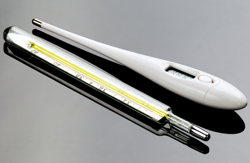Simple verification of temperature measurements
Since the 1980's when they were first introduced as a new non-invasive alternative measuring method, IRETs have become very popular. These battery-operated thermometers are inserted in the auditory canal without touching the osseous component or the tympanic membrane. The thermal emission from the medial aspects of the auditory canal is measured and readings are displayed within seconds. In order to be able to verify the accuracy and reliability of these readings, an experimental set-up was designed by researchers at the University of Ljubljana in Slovenia. This consists of a black body radiator approximating the ear canal. In the laboratory, a small hole to a larger cavity was used as a black body radiator through which almost no radiation passes and none is reflected. Light entering through the small hole would have to be reflected at the walls of the cavity multiple times before it escaped and would almost certainly be absorbed in the process. The black body cavity was immersed in a stirred water bath of stable temperature that was specifically designed for evaluating the IRETs' performance. Comparison measurements were performed with reference thermometers and black body cavities of different shape, temperature and emissivity. Deviations in the measurement of the same temperature with different thermometers were proven to be the result of an unusual combination of unfavourable influences. Heating of the IRET's detector when touched by the user's hand may influence the temperature measurement, as well as the operation of its electronic systems. Deviations were also observed when IRETs were positioned differently at the aperture of black body cavities. These findings represent useful information for users of IRETs and can prevent large measurement errors. On the other hand, the experience gained during the INCOLAB project was used for the development of a new code of practice for testing clinical thermometers against black body radiators. Project partners have actively participated in the harmonisation of measurements standards issued by the International Organisation for Standardisation and recommendations by the International Organisation of Legal Metrology.



